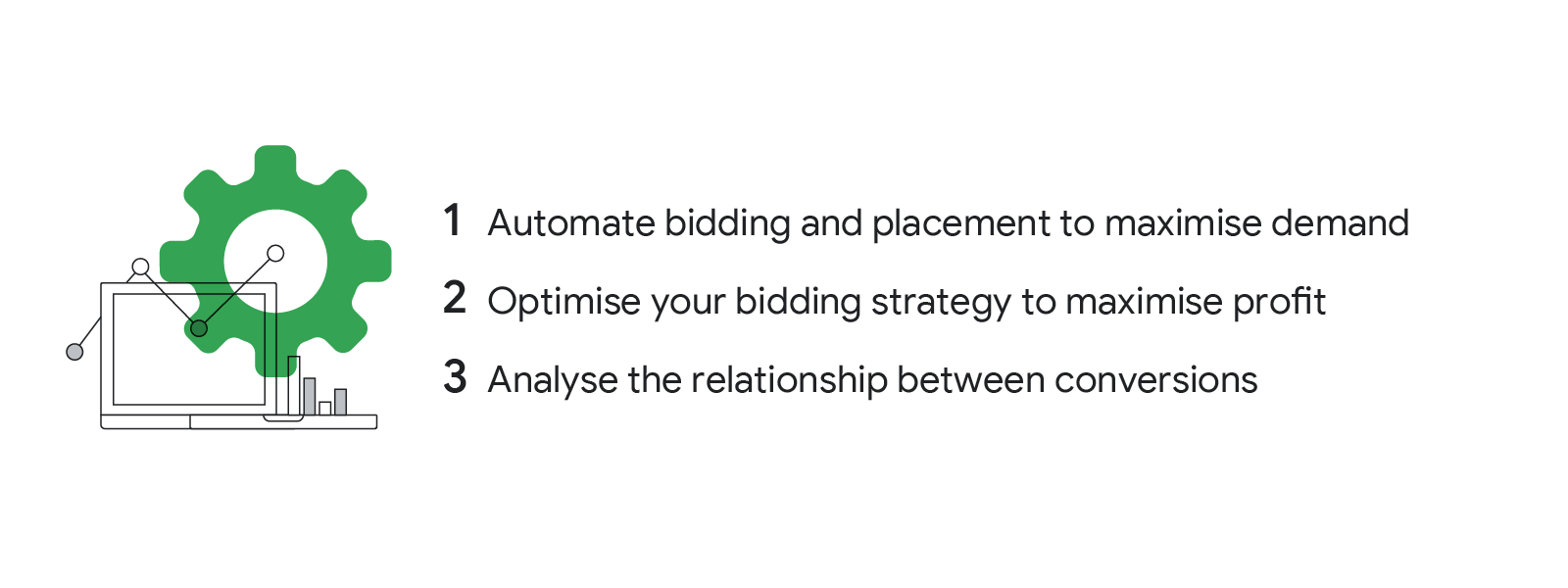Retailers and shoppers alike may hope that the festive shopping season feels closer to normal this year, but the reality is more complex.
With 73% of all retail search growth coming from new or rarely searched for terms1 — demand is out there — although it’s highly likely to shift. This makes predicting where shoppers will turn up a bigger challenge than ever before, especially with a reopened high street and ongoing supply chain issues compounding the complexity.
The digital maturity benchmark for retailers has been raised and the importance of automation has been elevated to adapt to these changes. We’ve identified three shopping trends and the associated actions retailers can take to capture seasonal demand and plan for lasting consumer change.
3 actions for marketers for the upcoming peak season

1. Demand is unpredictable and shoppers are more discerning
One thing we can be sure of this peak season: people are open to something different — be that new brands or considering products online they haven’t before.
70% of British Christmas shoppers say they are open to purchasing from retailers they haven’t bought from before.2 Plus, new behaviours have formed around online shopping that have irrevocably changed the way consumers buy, particularly in e-commerce converts aged 55 and above.
This backdrop makes it difficult to rely on historical demand patterns. Any retailer waiting to spot change, risks not seeing it until it’s too late — or possibly after their competitors have already made a move.
Action for marketers: Automate bidding and placement to maximise demand
With the U.K. coming out of a pandemic, Brexit, supply chain issues and shifts in consumer behaviour – demand is volatile and shopping behaviours are hard to predict. Automation enables rapid optimisation of budgets, bidding, and placement. Smart Bidding is the baseline required to remain competitive — for example, choosing a target return on advertising spend (tROAS) and using automation to set your bids and budget accordingly. This allows marketers to flex their spending in line with demand, with the aim of leaving nothing on the table.
A more advanced step is to incorporate smart campaigns, such as Smart Shopping, to both optimise your bids and make sure your activity has the most effective channel mix. This strategy has helped brands like Samsung, which increased its ROI on Smart Shopping campaigns by over 40%.

2. As e-commerce booms, measuring your customer value is key this Christmas
The high street might have reopened, but e-commerce continues to boom in the U.K.
It’s a retail opportunity that comes with a challenge: as more people go online to shop — and across more platforms and devices — reaching your most valuable customers becomes more complex. But it’s work worth doing.
U.K.-based retailer Moonpig measured across online touchpoints to ensure its ad bids were based on a holistic view of conversions. This helped them identify valuable customer groups and capture the full value of spend across Search and Shopping campaigns.
This can be done manually, with analysts reviewing massive data sets and segmenting customers into groups such as “basket abandoners” or “visitors in the past 30 days” and shaping campaigns accordingly.
However, you can be more nuanced and more effective by using machine learning instead. Campaigns can be optimised towards metrics such as customer lifetime value (CLV) and profit margins by adding first-party data on top of Google audience insights.
Action for marketers: Optimise your bidding strategy to maximise profit
Start by capturing first-party data, as this can help you segment your customers based on profitability and estimated lifetime value. Then use that information to inform your bidding strategy.
You can start simply by establishing a high, medium, and low customer segmentation to inform your bids. Then, move to the micro-level and optimise the metrics that make sense for your business and customers.
Feed in other data such as profit margins, and let automation help inform your e-commerce strategy. Privacy-safe tools like Customer Match, Similar Audiences, and Google Cloud Platform can do the heavy lifting in finding people similar to your current high-value customers and directing them towards relevant products that make the most business sense to you.
3. Over the holiday season, the link between online and offline shopping is increasingly critical
We know bidding for omnichannel transactions is complicated, even more so when it includes offline outcomes. Automation can come to the rescue here, effectively connecting the dots between online campaigns and in-store consumer spend.
Almost every consumer journey this Christmas will involve digital at some point, especially as people turn to YouTube and Search to find inspiration and ideas. But just because a journey starts online doesn't mean it will necessarily end there, with people also heading back into stores.
Retailers using automated tools to measure and understand these complex paths to purchase can plan more efficient campaigns and open valuable conversations with brand partners. For example, being able to demonstrate that an online ad for a Christmas toy has led to a shopper heading into a retailer to buy it is a valuable insight for any future partnership discussions.
Action for marketers: Analyse the relationship between conversions
A sophisticated omnichannel operation should be set up to look at the relationship between online and offline conversions. Here are four things to consider:
- Store Visits should be your first step: By using current and past first-party data on the number of people who clicked/viewed your ads and later visited your shop – you can then attribute your customer's offline action (a store visit) to your online marketing activity that influenced them.
- Go one step further by reporting on Store Sales: Upload your sales data from your stores to Google ads, where automation can match it up in a privacy-safe way. This will help inform your bidding strategy.
- Once you've measured the offline impact of your online activity: Optimise this data with Smart Bidding for store visits or sales.
- Use formats built specifically for driving offline sales, such as Local Campaigns and Local Inventory ads. These formats help drive your customers to your store by showing them where the nearest store is to them for the products they are looking for online.
This peak season, marketers shouldn’t have to choose between short-term wins and prioritising innovation. By embracing automation and these strategic points, brands and retailers can build resilience and capture demand – over Christmas and beyond – while establishing the foundations needed for long-term growth.






